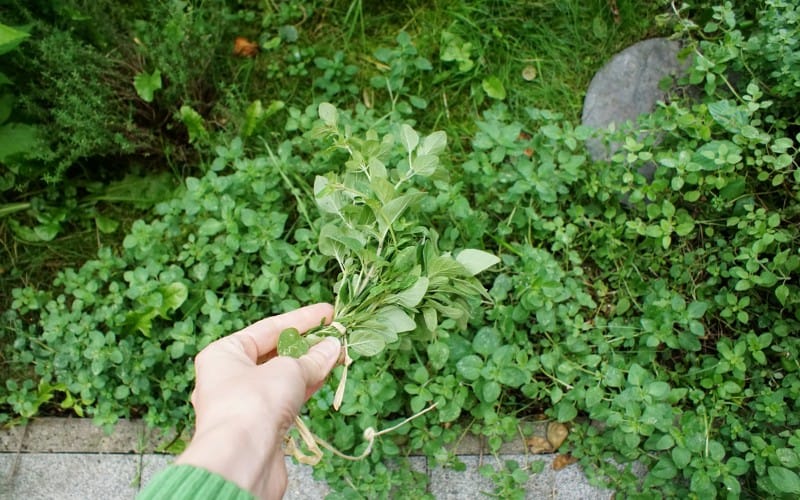To harvest oregano without killing the plant, you will need to cut off the stems about an inch or two above the ground. You can then dry the oregano by hanging it upside down in a warm, dry place. Once the oregano is dry, you can store it in an airtight container and use it as needed.
- Cut the oregano plant back to about 6 inches above the ground using sharp shears
- Make sure to cut any flower stalks off as well, as they will take away from the flavor of the leaves
- Allow the plant to regrow for a few weeks before harvesting again
How to Grow and Harvest Oregano
How Do You Pick Oregano So It Keeps Growing?
Oregano is a perennial herb that can reach up to two feet in height. The leaves are dark green and have a strong, pungent flavor. Oregano blooms from late spring to early summer with small, white or pink flowers.
To harvest oregano, cut individual stems back to about four inches above ground level. You can do this throughout the growing season as needed. Be sure to leave enough growth so that the plant can continue to thrive.
When drying oregano, hang the stems upside down in a well-ventilated area out of direct sunlight. After about a week, the leaves will be dry and crumbly. Store them in an airtight container away from light and moisture.
How Do You Know When Oregano is Ready to Pick?
When it comes to picking oregano, the best time to do so is when the plant is in full bloom. This typically occurs during the summer months. Once you have determined that the plant is in full bloom, simply cut off the stems that contain the leaves.
Be sure to cut them close to the base of the plant so that new growth can occur.
How Do You Pick And Store Fresh Oregano?
If you’re lucky enough to have a bumper crop of oregano in your garden (or were smart enough to buy a big bunch at the farmers market), here are some tips on how to pick and store it so you can enjoy that herby flavor all winter long.
First, wait until the plant is dry – if there’s any moisture on the leaves, they’ll mold when you store them. Cut off the stems about an inch or two from the ground, then gather them into bundles and tie with string or rubber bands.
Hang the bundles upside down in a cool, dry place for a week or so until the leaves are completely dried out.
Once they’re dry, strip the leaves from the stems and store in an airtight container – I like to use mason jars. Oregano will keep for several months stored this way.
If you find that your oregano is losing its flavor after a few weeks in storage, try crushing or grinding the leaves before using – this will release more of their flavor.
So there you have it – with just a little bit of effort, you can enjoy fresh oregano all year round!
Does Oregano Regrow After Cutting?
If you’re looking for an herb that’s easy to grow and care for, oregano is a great option. This hardy herb can be grown in both indoor and outdoor gardens, and it doesn’t take much effort to get it to thrive. Oregano is a perennial plant, which means that it will come back year after year once it’s established.
And if you want to keep a steady supply of this fragrant herb on hand, all you need to do is snip off a few sprigs when you need it and allow the plant to regrow.

Credit: gardeningbank.com
How to Dry Oregano
The best way to dry oregano is by hanging it upside down in bunches. You can do this by tying the stems together and suspending them from a clothes hanger, or any other type of hanger that will allow air to circulate around the herbs. Place the bunches in a cool, dark, and dry place such as an attic or closet for about two weeks.
Once the oregano is completely dried, carefully remove the leaves from the stems and store them in an airtight container away from direct sunlight.
How to Harvest Thyme Without Killing the Plant
Harvesting thyme is a delicate process that, if done correctly, will not kill the plant. The best time to harvest thyme is in the morning after the dew has evaporated but before the sun gets too hot. Start by snipping off the top few inches of the plant with sharp scissors.
Then, cut back any stems that have flowered or are woody. You can also pinch off individual leaves as needed. Be sure to leave some leaves on the plant so it can continue to photosynthesize and produce new growth.
When you’re finished harvesting, give the plant a light trimming and water it well. With proper care, your thyme plant will continue to thrive and provide you with fresh herbs for many seasons to come!
Harvesting Oregano After Flowering
If you’re growing oregano for its leaves, you can begin harvesting the herb as soon as it has several sets of leaves. However, if you want to harvest the flower buds or flowers, you’ll need to wait until the plant is in bloom. Cut oregano back by one-third to one-half after flowering to encourage new growth.
How to Harvest Sage Without Killing the Plant
Sage is a beautiful, fragrant herb that has many culinary and medicinal uses. But did you know that it’s also incredibly easy to harvest without killing the plant? Here’s how:
1. Cut off only the top third of the sage plant. This will encourage new growth and prevent the plant from becoming leggy.
2. Use sharp scissors or pruning shears to make clean cuts.
This will help prevent disease and pests from entering the plant.
3. Dry your sage leaves in a cool, dark place for best results. You can also freeze them for longer storage.
4. Enjoy your delicious, homegrown sage!
How to Harvest Rosemary Without Killing the Plant
Harvesting rosemary is a simple process that doesn’t require much time or effort. However, it’s important to do it correctly so that you don’t damage the plant. Here are some tips on how to harvest rosemary without killing the plant:
1. Cut off only the top third of the plant. This will encourage new growth and prevent the plant from becoming too leggy.
2. Use sharp scissors or pruning shears to make clean cuts.
Avoid crushing or tearing the leaves, as this can damage the plant.
3. Don’t remove all of the leaves from a single stem – leave some behind so that the plant can continue to photosynthesize and stay healthy.
4. Immediately after cutting, place the rosemary in a vase or container of water.
This will help keep it fresh for longer.
5. Enjoy your freshly harvested rosemary!
How to Harvest Parsley Without Killing the Plant
Parsley is a biennial herb that is typically grown as an annual. It is easy to grow and can be started from seed, transplants, or cuttings. Parsley is a versatile herb that can be used in many different dishes.
It has a mild flavor and can be used fresh or dried.
To harvest parsley without killing the plant, start by cutting off the outer leaves of the plant. You can then cut back the plant by one-third to one-half.
Once you have harvested the leaves, water the plant well and fertilize it if needed. Allow the plant to regrow before harvesting again.
How to Harvest Basil Without Killing the Plant
It’s easy to harvest basil without killing the plant. Just follow these simple tips:
1. Cut off the stems about an inch above where they branch off from the main stem.
This will encourage new growth.
2. Don’t take more than one-third of the leaves from any given stem. This will also help encourage new growth.
3. Use sharp scissors or pruning shears to make clean cuts. This will prevent damage to the plant and promote healing.
4. Gently remove the leaves from the stem, being careful not to tear them.
If you do accidentally tear a leaf, it’s okay – just be extra careful with that stem in future harvests.
5. Enjoy your fresh basil!
How to Harvest Mint Without Killing the Plant
Mint is a hardy plant that can withstand a lot of abuse, but if you want to harvest it without killing the plant, there are a few things you need to do. First, cut the stems about an inch or two above the ground. This will promote new growth and prevent the plant from being too stressed.
Second, only take what you need – don’t strip the plant of all its leaves. Third, make sure to water the plant well after harvesting. By following these simple steps, you can enjoy fresh mint while keeping your plants healthy and happy.
Conclusion
Harvesting oregano without killing the plant is possible if you follow these steps. First, cut back the plant by about one-third its height using sharp shears. Next, water the plant deeply a few hours before harvest time.
Then, carefully remove any flowers that have bloomed since the last watering. Finally, cut stems of oregano leaves close to the base of the plant using sharp shears.
